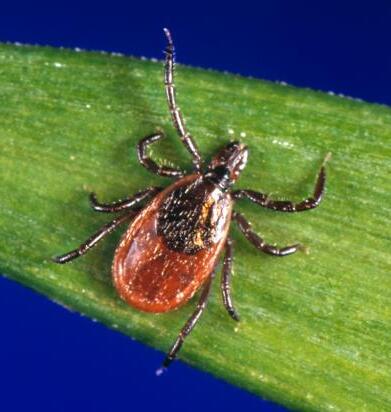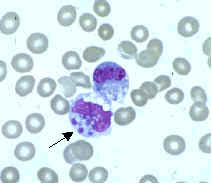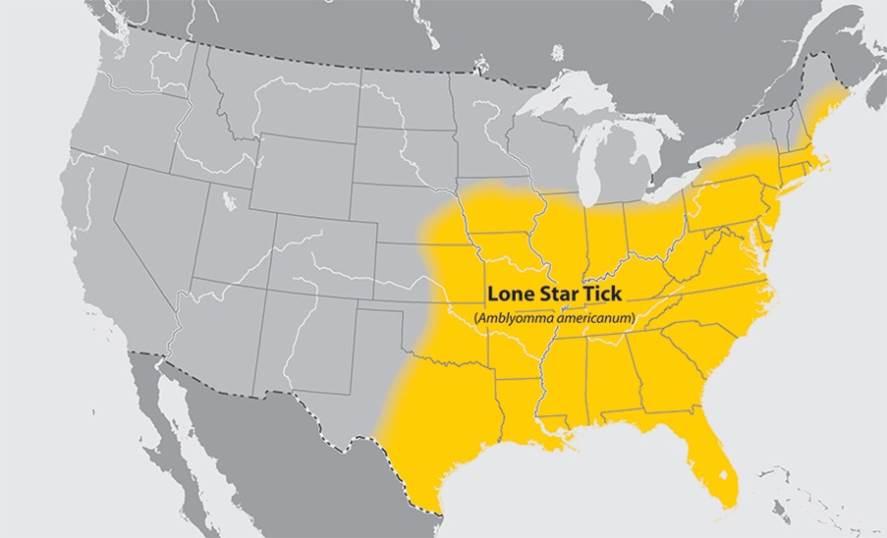|
Ehrlichiosis
Ehrlichiosis is a Tick-borne disease, tick-borne bacterial infection, caused by bacteria of the family Anaplasmataceae, genera ''Ehrlichia'' and ''Anaplasma''. These Obligate intracellular parasite, obligate intracellular bacteria infect and kill white blood cells. The average reported annual incidence is on the order of 2.3 cases per million people. Types Six (see note below) species have been shown to cause human infection: * ''Anaplasma phagocytophilum'' causes human granulocytic anaplasmosis. ''A. phagocytophilum'' is endemic to New England and the north-central and Pacific regions of the United States. * ''Ehrlichia ewingii'' causes human ewingii ehrlichiosis. ''E. ewingii'' primarily infects deer and dogs (see Ehrlichiosis (canine)). ''E. ewingii'' is most common in the south-central and southeastern states. * ''Ehrlichia chaffeensis'' causes human monocytic ehrlichiosis. ''E. chaffeensis'' is most common in the south-central and southeastern states. * ''Ehrlichia canis'' ... [...More Info...] [...Related Items...] OR: [Wikipedia] [Google] [Baidu] |
Ehrlichia Ewingii
''Ehrlichia ewingii'' is a species of rickettsiales bacteria. It has recently been associated with human infection, and can be detected via PCR serological testing. The name ''Ehrlichia ewingii'' was proposed in 1992. Taxonomy and characterization Taxonomy The current classification is Bacteria, Pseudomonadota, Alphaproteobacteria, Rickettsiales, Anaplasmataceae, ''Ehrlichia ewingii''. Classification of different members of the genus ''Ehrlichia'' has been disputed, however, it is generally agreed that close relatives of ''Ehrlichia ewingii'' are ''Ehrlichia chaffeensis'' and ''Ehrlichia canis''. It is also closely related to ''Wolbachia'', ''Anaplasma'', and '' Neorickettsia'' bacteria, with ''Rickettsia'' as a more distant genus. Characterization Species in the family Anaplasmataceae have unique characteristics that can help differentiate them from other families including: sensitivity to mechanical stress, changes in osmolarity, and thawing. &n ... [...More Info...] [...Related Items...] OR: [Wikipedia] [Google] [Baidu] |
Human Monocytic Ehrlichiosis
Human monocytotropic ehrlichiosis is a form of ehrlichiosis associated with ''Ehrlichia chaffeensis''. This bacterium is an obligate intracellular pathogen affecting monocytes and macrophages. Symptom and signs The most common symptoms are fever, headache, malaise, and muscle aches ( myalgia). Compared to human granulocytic anaplasmosis, rash is more common. Laboratory abnormalities include thrombocytopenia, leukopenia, and elevated liver tests. The severity of the illness can range from minor or asymptomatic to life-threatening. CNS involvement may occur. A serious septic or toxic shock-like picture can also develop, especially in patients with impaired immunity. Cause This disease is known to be caused by tick bites. Diagnosis Tick exposure is often overlooked. For patients living in high-prevalence areas who spend time outdoors, a high degree of clinical suspicion should be employed. Ehrlichia serologies can be negative in the acute period. Polymerase chain reaction i ... [...More Info...] [...Related Items...] OR: [Wikipedia] [Google] [Baidu] |
Ehrlichia Canis
''Ehrlichia canis'' is an obligate intracellular bacterium that acts as the causative agent of ehrlichiosis, a disease most commonly affecting canine species. This pathogen is present throughout the United States (but is most prominent in the South), South America, Asia, Africa and recently in the Kimberley region of Australia. First defined in 1935, ''E. canis'' emerged in the United States in 1963 and its presence has since been found in all 48 contiguous United States. Reported primarily in dogs, ''E. canis'' has also been documented in felines and humans, where it is transferred most commonly via ''Rhipicephalus sanguineus'', the brown dog tick. Transmission cycle The brown dog tick, ''R. sanguineus'', acts as the primary vector of ''E. canis'', transferring the pathogen between hosts during blood meals. Dogs, both domestic and wild, act as reservoir hosts for this pathogen and are the primary hosts of brown dog ticks. Brown dog ticks become carriers of the pathogen wh ... [...More Info...] [...Related Items...] OR: [Wikipedia] [Google] [Baidu] |
Human Granulocytic Anaplasmosis
Human granulocytic anaplasmosis (HGA) is a tick-borne, infectious disease caused by ''Anaplasma phagocytophilum'', an obligate intracellular bacterium that is typically transmitted to humans by ticks of the ''Ixodes ricinus'' species complex, including ''Ixodes scapularis'' and ''Ixodes pacificus'' in North America. These ticks also transmit Lyme disease and other tick-borne diseases. The bacteria infect white blood cells called neutrophils, causing changes in gene expression that prolong the life of these otherwise short-lived cells. Signs and symptoms Signs and symptoms may include: * fever * severe headache * muscle aches (myalgia) * chills and shaking, similar to the symptoms of influenza * nausea * vomiting * loss of appetite * unintentional weight loss * abdominal pain * cough * diarrhea, * aching joints * sensitivity to light * weakness * fatigue * change in mental status (extreme confusion, memory loss, inability to comprehend environment- interaction, reading, etc.) * te ... [...More Info...] [...Related Items...] OR: [Wikipedia] [Google] [Baidu] |
Ehrlichiosis (canine)
Ehrlichiosis (; also known as canine rickettsiosis, canine hemorrhagic fever, canine typhus, tracker dog disease, and tropical canine pancytopenia) is a tick-borne disease of dogs usually caused by the rickettsial agent '' Ehrlichia canis''. ''Ehrlichia canis'' is the pathogen of animals. Humans can become infected by ''E. canis'' and other species after tick exposure. German Shepherd Dogs are thought to be susceptible to a particularly severe form of the disease; other breeds generally have milder clinical signs. Cats can also be infected. ''Ehrlichia'' '' Ehrlichia'' is a rickettsial genus of bacteria belonging to the family Ehrlichiaceae. There are several species of ''Ehrlichia'', but the one that most commonly affects dogs and causes the most severe clinical signs is ''Ehrlichia canis''. This species infects monocytes in the peripheral blood. The brown dog tick, or ''Rhipicephalus sanguineous'', which passes the organism to the dog, is prevalent throughout most of the United ... [...More Info...] [...Related Items...] OR: [Wikipedia] [Google] [Baidu] |
Ehrlichia Muris
''Ehrlichia muris'' is a species of pathogenic bacteria first isolated from mice, with type strain AS145T. Its genome has been sequenced. References Further reading * * External linksLPSN*WISC entry Rickettsiales {{alphaproteobacteria-stub ... [...More Info...] [...Related Items...] OR: [Wikipedia] [Google] [Baidu] |
Ehrlichia
''Ehrlichia'' is a genus of Rickettsiales bacteria that are transmitted to vertebrates by ticks. These bacteria cause the disease ehrlichiosis, which is considered zoonotic, because the main reservoirs for the disease are animals. ''Ehrlichia'' species are obligately intracellular pathogens and are transported between cells through the host cell filopodia during initial stages of infection, whereas in the final stages of infection, the pathogen ruptures the host cell membrane. History The genus ''Ehrlichia'' is named after German microbiologist Paul Ehrlich. The first ehrlichial disease was recognized in South Africa during the 19th century. Its tick-borne nature was determined in 1900. The organism itself was demonstrated in 1925 when it was recognized to be a ''Rickettsia''. It was initially named ''Rickettsia ruminantium'', and is currently named ''Ehrlichia ruminantium''. In 1945, an "infection and treatment" method for livestock was developed. This is still the only comme ... [...More Info...] [...Related Items...] OR: [Wikipedia] [Google] [Baidu] |
Human Ewingii Ehrlichiosis
''Ehrlichiosis ewingii'' infection is an infectious disease caused by an intracellular bacteria, ''Ehrlichia ewingii''. The infection is transmitted to humans by the tick, ''Amblyomma americanum''. This tick can also transmit ''Ehrlichia chaffeensis'', the bacteria that causes human monocytic ehrlichiosis (HME). Symptoms and signs Patients can present with fever, headache, myalgias, and malaise. Laboratory tests may reveal thrombocytopenia, leukopenia, and evidence of liver damage. Mechanism Humans contract the disease after a bite by an infected tick of the species ''Amblyomma americanum''. Those with an underlying immunodeficiency (such as HIV) appear to be at greater risk of contracting the disease. Compared to HME, ewingii ehrlichiosis has a decreased incidence of complications. Like ''Anaplasma phagocytophilum'', the causative agent of human granulocytic ehrlichiosis, ''Ehrlichia ewingii'' infects neutrophils. Infection with ''E. ewingii'' may delay neutrophil apoptosis. ... [...More Info...] [...Related Items...] OR: [Wikipedia] [Google] [Baidu] |
Ehrlichia Chaffeensis
''Ehrlichia chaffeensis'' is an obligate intracellular, Gram-negative species of Rickettsiales bacteria. It is a zoonotic pathogen transmitted to humans by the Amblyomma americanum, lone star tick (''Amblyomma americanum''). It is the causative agent of human monocytic ehrlichiosis. Genetic studies support the endosymbiotic theory that a subset of these organisms evolved to live inside mammalian cells as mitochondria to provide cellular energy to the cells in return for protection and sustenance. ATP production in the rickettsiae is biochemically identical to that in mammalian mitochondria; all multi-cellular eukaryotes have mitochondria in their cells, including birds, fish, reptiles, invertebrates, plants, and fungi in addition to mammals. Human monocytic ehrlichiosis caused by ''E. chaffeensis'' is known to spread through tick infection primarily in the Southern, South-central and Mid-Atlantic regions of the United States. In recent years, the lone star tick has expanded i ... [...More Info...] [...Related Items...] OR: [Wikipedia] [Google] [Baidu] |
Amblyomma Americanum
''Amblyomma americanum'', also known as the lone star tick, the northeastern water tick, or the turkey tick, or the "Cricker Tick", is a type of tick indigenous to much of the eastern United States and Mexico, that bites painlessly and commonly goes unnoticed, remaining attached to its host for as long as seven days until it is fully engorged with blood. It is a member of the phylum Arthropoda, class Arachnida. The adult lone star tick is sexually dimorphic, named for a silvery-white, star-shaped spot or "lone star" present near the center of the posterior portion of the adult female shield (scutum); adult males conversely have varied white streaks or spots around the margins of their shields. ''A. americanum'' is also referred to as the turkey tick in some Midwestern U.S. states, where wild turkeys are a common host for immature ticks. It is the primary vector of ''Ehrlichia chaffeensis'', which causes human monocytic ehrlichiosis, and ''Ehrlichia ewingii'', which causes human a ... [...More Info...] [...Related Items...] OR: [Wikipedia] [Google] [Baidu] |
Minnesota
Minnesota () is a state in the upper midwestern region of the United States. It is the 12th largest U.S. state in area and the 22nd most populous, with over 5.75 million residents. Minnesota is home to western prairies, now given over to intensive agriculture; deciduous forests in the southeast, now partially cleared, farmed, and settled; and the less populated North Woods, used for mining, forestry, and recreation. Roughly a third of the state is covered in forests, and it is known as the "Land of 10,000 Lakes" for having over 14,000 bodies of fresh water of at least ten acres. More than 60% of Minnesotans live in the Minneapolis–Saint Paul metropolitan area, known as the "Twin Cities", the state's main political, economic, and cultural hub. With a population of about 3.7 million, the Twin Cities is the 16th largest metropolitan area in the U.S. Other minor metropolitan and micropolitan statistical areas in the state include Duluth, Mankato, Moorhead, Rochester, and ... [...More Info...] [...Related Items...] OR: [Wikipedia] [Google] [Baidu] |
Mayo Clinic
The Mayo Clinic () is a nonprofit American academic medical center focused on integrated health care, education, and research. It employs over 4,500 physicians and scientists, along with another 58,400 administrative and allied health staff, across three major campuses: Rochester, Minnesota; Jacksonville, Florida; and Phoenix/Scottsdale, Arizona. The practice specializes in treating difficult cases through tertiary care and destination medicine. It is home to the top-15 ranked Mayo Clinic Alix School of Medicine in addition to many of the highest regarded residency education programs in the United States. It spends over $660 million a year on research and has more than 3,000 full-time research personnel. William Worrall Mayo settled his family in Rochester in 1864 and opened a sole proprietorship medical practice that evolved under his sons, Will and Charlie Mayo, along with practice partners Stinchfield, Graham, Plummer, Millet, Judd, and Balfour, into Mayo Clinic. Toda ... [...More Info...] [...Related Items...] OR: [Wikipedia] [Google] [Baidu] |



